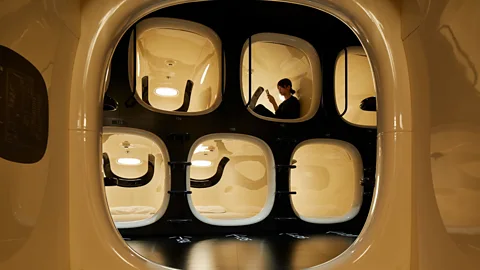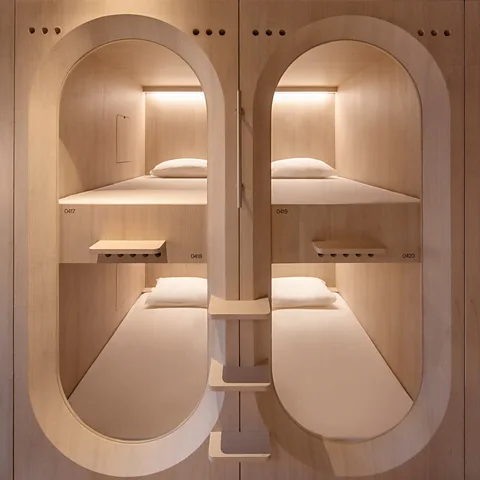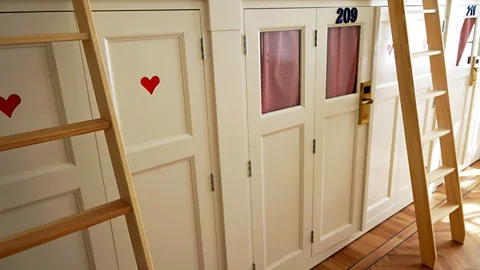Eight of the world's most extraordinary tiny hotel rooms
 Natura Vive
Natura ViveFrom Colombia's upcycled sewer pipes to spheres suspended in the sky in Canada, capsule hotels have been reinvented for a new generation of travellers.
By night, the world's first capsule hotel (founded in Osaka, Japan in 1979) must have looked like a morgue, with neat rows of narrow sleeping capsules each containing a recumbent body. But the following day, the occupants – mostly businessmen who had worked late - would rise up and head back to the office, grateful for this efficient sleep solution that had saved them a commute home in the early hours.
As the concept spread, tourists happy to sleep in a room no bigger than its bed began to bunk up alongside them, eager to sample this unusual aspect of Japanese culture. Fast-forward to today, and high hotel room rates, fuelled by years of rising real estate prices, have supercharged this typically low-cost concept, which offers budget travellers priced out of traditional hotels more privacy than a hostel dormitory and more comfort and connectivity than camping. The capsules, which are predominantly single-occupancy, also answer the current boom in solo travel, with single-sex capsule hotels providing additional security.
With the global capsule hotel market projected to reach $327m by 2031, curious hybrids have emerged to sustain the trend and attract new customers. They're tempting the TikTok generation with increasingly outlandish forms, from upcycled sewer pipes in the Colombian desert to space-age pods with a dashboard of ambient controls in downtown Sydney, Australia – all promising a unique experience and shareable stories for social media. Meanwhile capsule-cum-bookstores invite book lovers to snooze among the shelves, and boutique versions bring luxury to a traditionally no-frills market with fancy decor or promises of fluffy duck-feather duvets.
As the concept continues to reinvent itself, here are eight of the most extraordinary examples.
 Nine Hours
Nine HoursA sleep laboratory
Nine Hours, a chain of 13 hotels across Japan, from Fukuoka in the west to the north-east island of Hokkaido, has an unusual by-product: sleep data. In the Shinagawa Station (men only) and Akasaka branches, guests can sign up for a "9h sleep fitscan" service, where sensors detect everything from breathing to facial expressions to generate a sleep report that tracks their heart rate, identifies sleep apnea and even monitors snoring. In a sector where a novel or low-budget stay is often prioritised over comfort, Nine Hours' interest in how well its guests are sleeping sets it apart.
Across the franchise, the white, minimalist decor continues this clinical theme, while its rows of sleek, shiny sleeping pods would not look out of place on the set of a science-fiction movie. The name refers to the hotel's cost-cutting concept that reduces room rental to the essential nine hours, allowing seven hours for sleep and an hour on either side for washing and dressing. Just need a nap? Hourly rates are also available.
 Natura Vive
Natura ViveClimb to the sky
A night in a transparent sleeping pod clinging to a cliff face above Peru's Sacred Valley is not everyone's idea of a relaxing stay, but for adrenaline-lovers, it's hard to beat – not least for the incredible 300-degree views of the surrounding mountains and the formidable condors that inhabit them.
A near-vertical climb of 400m is the only way to reach the Skylodge Adventure Suites, but climbing experience is not necessary – only good health and a head for heights – and descending is speedier thanks to a series of zip wires. Each capsule includes a private bathroom ensuring that night trips to the toilet are not life-threatening, and when the sun rises, you can enjoy a cup of tea on your private deck. Looking for a little more luxury? A little further down the Urubamba river, sister site, Starlodge, adds hillside hot tubs to the capsule hotel experience.
 Tubo Hotel La Tatacoa
Tubo Hotel La TatacoaA desert oasis
The Tubo Hotel, La Tatacoa is just a 10-minute drive from Colombia's second-largest desert, the eponymous Tatacoa, famous for its clear starry skies. When you've taken in the giant cacti and curious rock formations of the Tatacoa's cinnamon-coloured sands, this rainbow of tiny, air-conditioned rooms with a shared swimming pool offers a welcome oasis. The 37 capsules are fashioned from concrete sewer pipes painted in candy colours, providing just enough room for a double bed. Almost half of the rooms have a shared bathroom, but the room rate is a snip and you've a shady garden, bar and restaurant on your doorstep. "This innovative and colourful place offers you a unique experience," says Ambar Quintana, the hotel's administrator. "It has everything you need to rest in a natural environment of fresh air and vegetation."
 Tom Chudleigh
Tom ChudleighImmerse in nature
Suspended among the conifers like oversized Christmas baubles, the Free Spirit Spheres on Vancouver Island, Canada, feel "like you are floating in the canopy among the sleeping birds", according to owner Tom Chudleigh. The first sphere was introduced 25 years ago, driven by a desire to promote ecotourism and preserve Canada's ancient forests.
More like this:
There are currently three spheres, each based on the principle of biomimicry and shaped with a giant seed pod or nutshell in mind: light but with a strong shell. "Eryn" is fashioned from Sitka spruce and has a dining area, sink and slightly undersized double bed inside; while more recent additions, "Melody" and "Luna", are fibreglass and have similar amenities but with full-size double beds that can be stowed. Each sphere is accessed via a spiral staircase wrapped around a tree, and is available to rent in temperatures as low as -20C, when even a trip to the composting toilet at the accommodation's base will feel intrepid.
The shape makes bespoke fittings a prerequisite, and every little detail has been meticulously crafted by Chudleigh, from walnut fold-out furniture that maximises the space, to door handles cast from bronze.
 KINN Capsule
KINN CapsuleSmall but soothing
Inside a Brutalist building in Singapore's Chinatown lies a surprisingly serene interior. Opened in 2021 and based on an aesthetic it describes as "soft minimalist", KINN Capsule offers a Zen take on the capsule concept with walls painted in calming peachy tones and pale wood sleeping chambers fitted with crisp white bed linen. Even the smell of the place seems an antidote to its urban location as a special house fragrance designed to evoke the wildflowers of a Nordic forest hangs in the air. There are 72 capsules in total, sealed off with blackout blinds and spread across seven rooms, but the vibe is more boutique than bunkhouse.
 Suschengliang
SuschengliangA book at bedtime
A traditional mud and wood farmhouse in eastern China's Zhejiang Province got a prize-winning makeover in 2019 when it reopened as a capsule hostel, bookstore and community library, sleeping 20 in tiny single bed-sized compartments concealed between bookshelves made of local bamboo. A smattering of small landings are connected by zigzagging stairways that recall the serpentine paths of the surrounding forests of Tonglu. It's hard to know which is more dramatic: the remote building's transparent floor-to-ceiling panels that light it up like a cathedral at night, or the lush mountainous scenery that's visible through them.
 De Bedstee Hotel
De Bedstee HotelCupboard love
In Oud Zuid, one of Amsterdam's most upscale neighbourhoods, guests are paying to sleep in cupboards. The quirky De Bedstee Hotel draws on the 17th-Century tradition of the Dutch bedstee (box bed), a bed concealed behind cupboard doors to create a cosy sleeping nook. The hotel's Art Deco features and acid-coloured wallpapers downstairs give way to a shabby-chic design in the first-floor dormitories, where the bedstee windows are framed by red gingham curtains and little wooden ladders lead to the capsules above. Relax in the hotel's small terrace garden or take a half-hour stroll to the Rembrandt House Museum in the city centre to see several historic box beds in situ.
 Resol Poshtel Tokyo Asakusa
Resol Poshtel Tokyo AsakusaPristine and comparatively posh
Another hotel with a signature smell is the Resol Poshtel in Tokyo's Asakusa district – the Resol Hotel chain's first venture into capsule sleeping. The aroma, which includes orange, chamomile and neroli, is said to induce "a feeling of gentle calm" – of benefit, perhaps, given the communal sleeping arrangements. At bedtime, there's nothing but a curtain between you and fellow visitors, but few one-star establishments can match this hotel's cleanliness and functionality, with hairbrushes, slippers and razors included in the freebies. The Edo-era styling − such as the sleeping cubicles' arched entrance reminiscent of tea ceremony rooms, and the traditional Japanese murals surrounding the bed − add a hint of heritage to the hotel's modern lines. The city's oldest Buddhist temple, Sensō-ji, is a five-minute walk away, as is the lantern-lined Nakamise-dori street, home to a parade of colourful shops selling souvenirs and street food.
--
This story was first published in August and was one of our most-read Travel stories of the year.
If you liked this story, sign up for The Essential List newsletter – a handpicked selection of features, videos and can't-miss news, delivered to your inbox twice a week.
